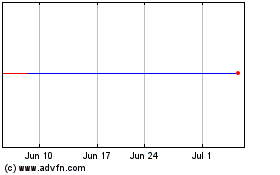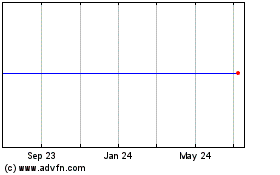Poultry Shares Heat Up With Lifting of China Export Ban
October 30 2019 - 3:35PM
Dow Jones News
By Kirk Maltais and Ryan Dezember
Share prices of chicken producers have taken flight following
China's lifting of a four-year old ban on importing poultry from
the U.S.
The gains came after Chinese officials said over the weekend
that they and U.S. counterparts reached a deal in which the U.S.
would allow imports of Chinese cooked chicken and seafood products
in exchange for China scrapping the ban on U.S. poultry shipments.
The pact, reached amid the broader trade dispute between the
countries, caused poultry stocks to pop.
The ban was instituted in 2015 in response to outbreaks of avian
influenza in the U.S. Lately, however, China has struggled with an
outbreak of African swine fever that has cost the country roughly
40% of its hog herd and initiated a scramble for alternative
proteins.
Sanderson Farms Inc. shares got the biggest boost, jumping
nearly 16% on Monday, headed toward the stock's biggest one-day
move in more than a decade. Shares of rivals Pilgrim's Pride Corp.
and Tyson Foods Inc. rose 4.6% and 8.3%, respectively. Those three
companies accounted for nearly half of the ready-to-cook chicken
produced in the U.S. last year, according to Sanderson.
Prices for chicken in the U.S. have yet to jump like the shares
of producers have, but they are expected to rise alongside
shipments to China.
"It can and likely will move U.S. poultry prices higher," said
Dennis Smith, a commodities broker with Archer Financial Services
Inc. "Seeing China drop this ban...simply confirms that they need
protein."
Domestic prices for whole broilers -- younger chickens weighing
2.5 to 4.5 pounds -- fell last week to 78.31 cents a pound, down
8.2% from the same time last year, according to U.S. Agriculture
Department data. Ample domestic supplies have dragged down prices,
but demand for dark-meat chicken on the export market is expected
to move faster thanks to "increased export interest," the USDA said
Tuesday.
The Chinese National Bureau of Statistics said earlier this
month that prices for Chinese pork had risen 69% from a year
earlier due to the African swine fever epidemic. The USDA projects
that China's swine herd will fall to 275 million pigs, from 428
million pigs in 2018.
Simon Powell, an analyst with Jefferies Financial Group Inc.,
said this week that it is unclear if there is enough spare
production capacity to replace the estimated 20 million metric tons
of meat, equal to about 6% of total annual global supply, that has
been lost as a result.
"There is limited spare capacity to help fill the hole in
China," Mr. Powell wrote in a note to clients. "Asian consumers
want pork and, in its absence, may simply pay the higher price and
consume less, but at the same time there will be some shift to
other protein."
China imported 342,000 metric tons of chicken in 2018, and is
expected to more than double its annual intake to 750,000 tons in
2020, according to the USDA.
The opportunity to fill China's pork gap with chicken has U.S.
poultry executives salivating.
"Whether the United States is a direct supplier to China or
whether they source from other countries to the extent that they
can...that creates backfill opportunities for us," Tyson Chief
Executive Noel White told investors at an industry conference last
month. "Any time that there is that amount of protein that is lost
from a global perspective, there is going to be an impact on
price."
Write to Kirk Maltais at Kirk.Maltais@wsj.com and Ryan Dezember
at ryan.dezember@wsj.com
(END) Dow Jones Newswires
October 30, 2019 15:20 ET (19:20 GMT)
Copyright (c) 2019 Dow Jones & Company, Inc.
Sanderson Farms (NASDAQ:SAFM)
Historical Stock Chart
From Mar 2024 to Apr 2024

Sanderson Farms (NASDAQ:SAFM)
Historical Stock Chart
From Apr 2023 to Apr 2024
